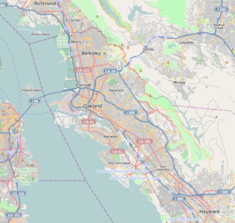Rancho San Antonio (Peralta)
| Rancho San Antonio (Peralta Grant) | |
|---|---|
 |
|
| Location | NW corner of E. 14th and Hays Sts., San Leandro, California |
| Coordinates | 37°43′38″N 122°09′29″W / 37.727167°N 122.157917°WCoordinates: 37°43′38″N 122°09′29″W / 37.727167°N 122.157917°W |
| Built | 1820 |
| Designated | 1936 |
| Reference no. | 246 |
Rancho San Antonio, also known as the Peralta Grant, was a 44,800-acre (181 km2) land grant by Governor Pablo Vicente de Solá, the last Spanish governor of California, to Don Luís María Peralta, a sergeant in the Spanish Army and later, commissioner of the Pueblo of San José, in recognition of his forty years of service. The grant, issued on August 3, 1820, embraced the sites of the cities of San Leandro, Oakland, Alameda, Emeryville, Piedmont, Berkeley, and Albany.
Luís María Peralta never lived on the rancho himself, but his four sons and their families did. With their wives, families, landless Mexican laborers, and surrounding native peoples, the Peralta sons established the first Spanish-speaking communities in the East Bay. As the rancho prospered, the Peralta brothers built newer and bigger houses. The main hacienda contained two adobes, and some twenty guest houses, and became an established stop for travelers along what was during the Spanish era the only camino real on the eastern side of San Francisco Bay.
The hacienda became the social and commercial center of this vast rancho. Annual rodeos and cattle round-ups, horse racing, and games often took place here. The Peraltas eventually had over 8,000 head of cattle and 2,000 horses grazing on the rancho, and built a wharf on the bay near the hacienda headquarters in order to trade the rawhide and tallow produced by their cattle. The Peralta family built a total of 16 houses over a fifty-year period on Rancho San Antonio. There were eleven adobes, three frame houses, one brick house, and one built of "logs and dirt" (the very first structure built). Son Domingo's home was located on Codornices Creek adjacent to the site of what is today St. Mary's College High School. Son Vicente's home was located in what is today the heart of Oakland's Temescal district.
...
Wikipedia

